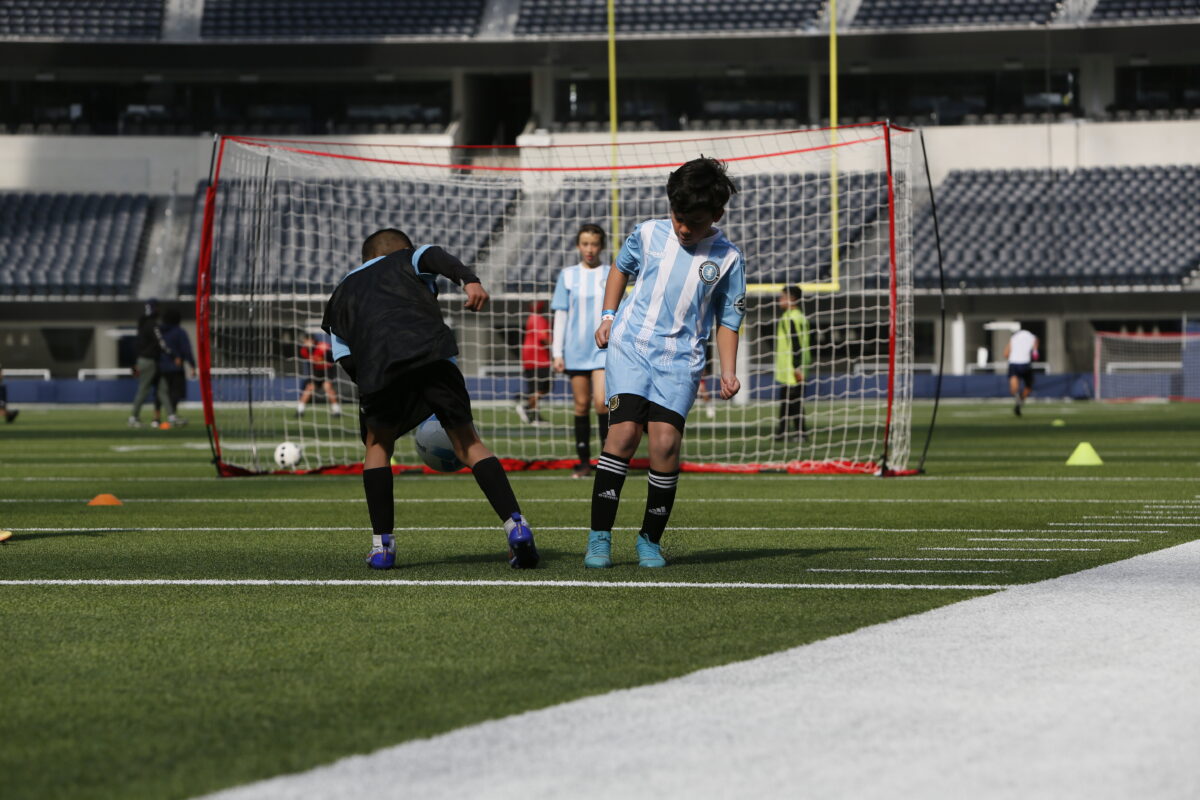Creating an Engaging Youth Sports Environment with Small-Sided Games
When it comes to youth sports coaching, creating an environment that fosters growth, enjoyment, and skill development is crucial. In this blog post, we’ll explore the concept of small-sided games and how they contribute to an engaging and child-centered coaching approach. Let’s dive into optimizing your youth sports program for success.
The Foundation: A Child-Centered Approach
The environment is everything! How your child feels when they are on the way to a class, when they arrive, and how they leave is a direct result of the environment. Not just built by the coach but in partnership with the child and importantly the parents.
Research into understanding what children want from sport and why they play sports has been conducted extensively. For any coach or club, this should be of paramount importance. In their survey, the top four answers they received from children were:
| WHY DO CHILDREN PLAY SPORTS? | WHY DO CHILDREN STOP PLAYING? |
|---|---|
| It’s Fun! | Boredom |
| They Like Learning! | Criticism & Yelling |
| Being With Friends! | Lack Of Playing Time |
| Enjoyment & Excitement Of Competition! | Emphasis On Winning |
Why They Play – A University of Notre Dame Research Project into Youth Sports Participation
Small-Sided Games: The Key to Engagement
One effective way to enhance the youth sports experience is through the use of small-sided games. These games break down sports into smaller groups, allowing for increased engagement, decision-making, and skill development.
Exhibit number one: Manchester United 4v4 versus 8v8 Study.
In research carried out by Rick Fenoglio as part of a study performed by the Department of Exercise and Sport Science at the Manchester Metropolitan University, ran a pilot program attempting to optimize the “window of opportunity” that exists for skill development in the U9 range. Both quantitative and qualitative data sets were collected from the study group. Scientifically speaking it may not have the largest sample size but is valid and reliable enough to use as an indicator toward behavior changes for coaches and clubs. It is also peer-reviewed so we will continue. The outcomes of the research were interesting and focused on comparing the differences in 4v4 to 8v8 sized games of soccer. Elements of the games that were analyzed included data such as touches, goal attempts, and goals scored, 1v1 situations, and more.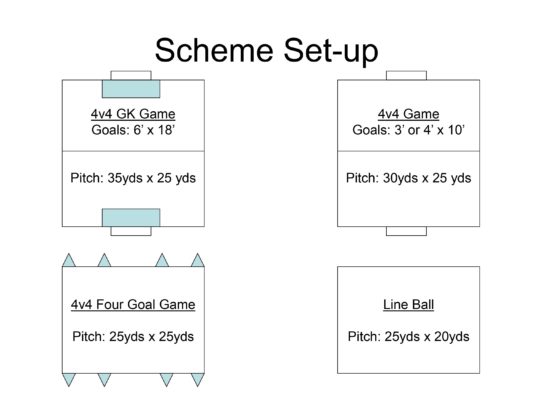
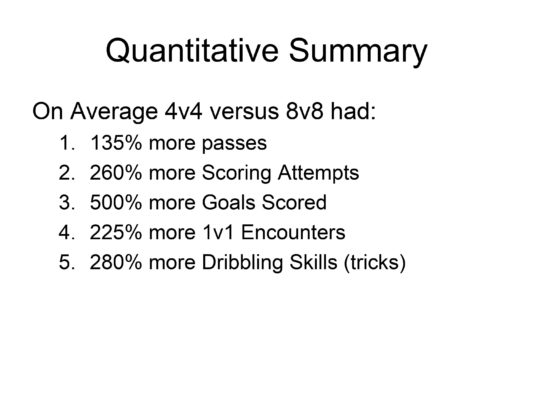
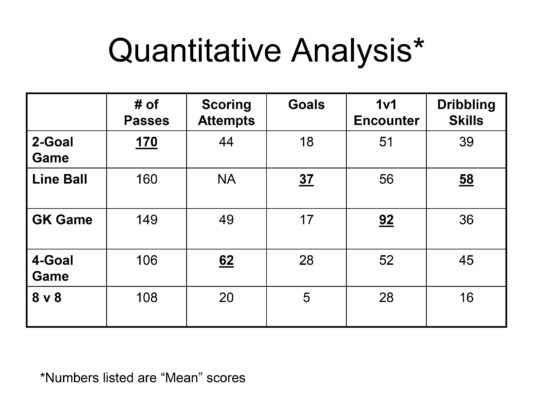
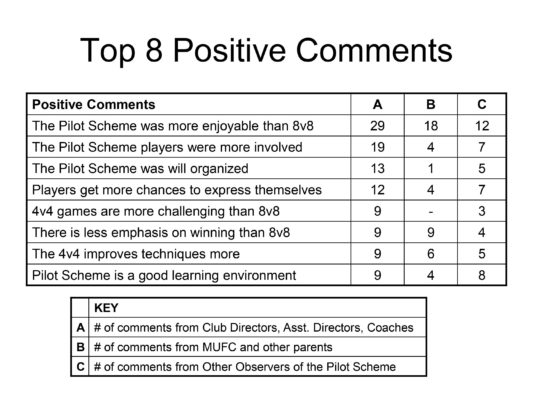
Exhibit number two: Olympique Lyonnais
So how else does K.I.S.S going to support your children? My years in the USA tell me that conditioning is often on the front of parents’ minds. Having an active child, physically fit, able to run for days. I hear the question, “If they only play in 30 x 20 yards of space, how are they fit? Where are the laps? The sprints?” I got you here too! A study conducted by the French club, Olympique Lyonnais of Ligue 1, one of the world’s leaders in development in soccer, was looking into the differences in technical and physical workloads between small-sided games and large-sided games. They concluded, “Compared to match-play, total distance covered per minute of play, high-intensity running activities (sprinting and high-intensity runs), total numbers of duels and lost ball possessions were significantly greater within SSGs for all playing positions.” They added “The relevance and interest of SSGs in modern soccer training can be attributed to the fact that they offer a multifunctional training benefit by influencing simultaneously players’ physical, technical, and tactical abilities (Owen et al., 2004, 2011).
Exhibit number three: Valter Di Salvo
Another study by Valter Di Salvo (also former Manchester United, Real Madrid, and Lazio fitness coach) and others on the “Influence of the Numbers of Players in the Heart Rate Responses of Youth Soccer Players Within 2 vs. 2, 3 vs. 3 and 4 vs. 4 Small‐sided Games” part of their conclusion included this “The results of the present study suggest that the 2 vs. 2 and 3 vs. 3 SSG could also stimulate a high percentage of VO2max in youth soccer players. Youth soccer players need to develop their physical performance (maximal aerobic capacity and ability to repeated sprints), technical, and tactical abilities. Therefore, the use of 2 vs. 2 and 3 vs. 3 SSG seems to represent an ideal alternative to optimize simultaneously these components in youth soccer players.”
Exhibit four: Norway
Norway and the other Scandinavian countries have heavily invested in research such as this, talent identification, and development. The research paper titled “Skill acquisition in a professional and non-professional U16 football team: the use of playing form versus training form” Also known as isolated technical practice vs. playing games. A comment within the research notes “Activities such as small-sided games are a much-recommended activity because of their open nature, in which players need to make constant decisions and perform technically and physically, and therefore contain, if organized well, all the necessary skills in soccer…This indicates that the game itself should be the focal learning point, because of the changing environment and complex dynamics, which, in a broader sense, enhance the development of functional technical skills, decision making, and tactical behavior in the field.”
In Summary
One of the interesting observations in these studies, even with varied intents of the research, whether they’re focused on the physiological aspect, enjoyment, and engagement, technical/skill acquisition, is that all nod toward the holistic nature of small-sided games. Technical, tactical, physical. Best of all worlds. Something that the US Soccer Federation has made in its adaptations in their coaching qualifications has specific courses for 4v4 soccer. Their effectiveness and uptake within the community and culture remain to be seen. I am hopeful!
My intention with my blog is to share views and thoughts on the youth sports world, particularly the environment we find ourselves in, and how we can improve together. The journey of a child through sports is about teamwork and partnership between all the key people in their lives. Whether you’re attending my classes, someone else’s, or supporting your local youth soccer league, we are obliged to leave a lasting positive impression on children in sports.
The use of small-sided games in youth sport is imperative. By using modified, smaller numbered games, we are maximizing how much of the individual we put at the center of the experience. We increase the opportunities for each child to learn within their sporting context, whether it’s to bounce a ball, throw it, kick it, and hit it, we are able to give them the chance to learn and develop all of those technical elements, with tactical understanding (when and why) and physical gains.
Formats as simple as 1v1, 2v2, 3v3 even 1v2, 3v2, keep the games realistic to the sports we see on TV and ensure solutions become transferrable as children grow through the sport. Modifying the games to be shorter in time allows greater repetition. Reflecting quickly on previous challenges and building solutions for the next. To get over one success or failure quickly and concentrate on the next. Building character. We are allowing the child to have both hands on their wheel with us sitting alongside supporting. Not us driving the car.
Keep. It. Small. Sided (Games)
Matt
